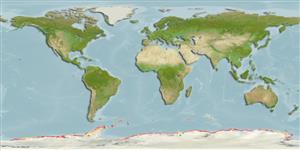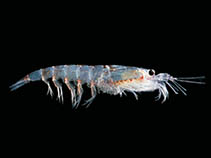Euphausia superba Dana, 1850
Antarctic krill| Native range | All suitable habitat | Point map | Year 2050 |

|
| This map was computer-generated and has not yet been reviewed. |
| Euphausia superba AquaMaps Data sources: GBIF OBIS |
Classification / Names Populärnamn | synonymer | CoL | ITIS | WoRMS
Malacostraca | Euphausiacea | Euphausiidae
Environment: milieu / climate zone / djupintervall / distribution range Ekologi
Pelagiska; djupintervall 15 - 130 m (Ref. 111951). Polar, preferred -1°C (Ref. 107945); 46°S - 78°S, 180°W - 180°E
Distribution Länder | FAO områden | Ekosystem | Förekomster | Utplanteringar
Circumpolar in the Southern Ocean.
Length at first maturity / Size / Weight / Age
Könsmognad: Lm ? range ? - ? cm Max length : 3.0 cm TL hane/ej könsbestämd; (Ref. 101405)
Life cycle and mating behavior Könsmognad | Reproduktion | Lek | Eggs | Fecundity | Larvae
Main reference
referenser | Koordinator | Medarbetare
Brinton, E. 1962 The distribution of Pacific euphausiids. 8(2), 51-270. In Fox, D.L., Arrhenius, G.O.S., Phleger, F.B. (eds.), Contribution from the Scripps Institution of Oceanography. Bulletin of the Scripps Institution of Oceanography of the Univeristy of California. University of California Press. California. (Ref. 2864)
IUCN Red List Status
(Ref. 130435: Version 2025-1)
CITES status (Ref. 108899)
CMS (Ref. 116361)
Threat to humans
Human uses
Fiskeri: kommersiell
FAO - fiskeri: landings, species profile | FIRMS (Stock assessments) | FishSource | Sea Around Us
Verktyg
Ytterligare information
Max. ages / sizes
Length-weight rel.
Length-length rel.
Length-frequencies
Mass conversion
Abundans
Könsmognad
Fecundity
Lek
Eggs
Egg development
Larvae
Internet-källor
BHL | BOLD Systems | CISTI | DiscoverLife | FAO(fiskeri: species profile; publication : search) | Fishipedia | GenBank (genome, nucleotide) | GloBI | Gomexsi | Google Books | Google Scholar | Google | PubMed | Tree of Life | Wikipedia (Go, sök) | Zoological Record



